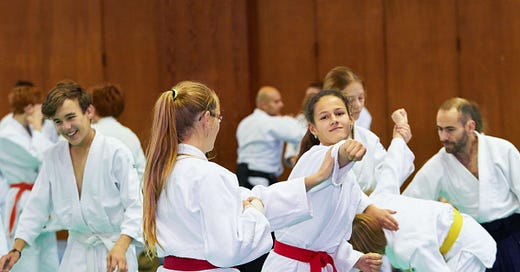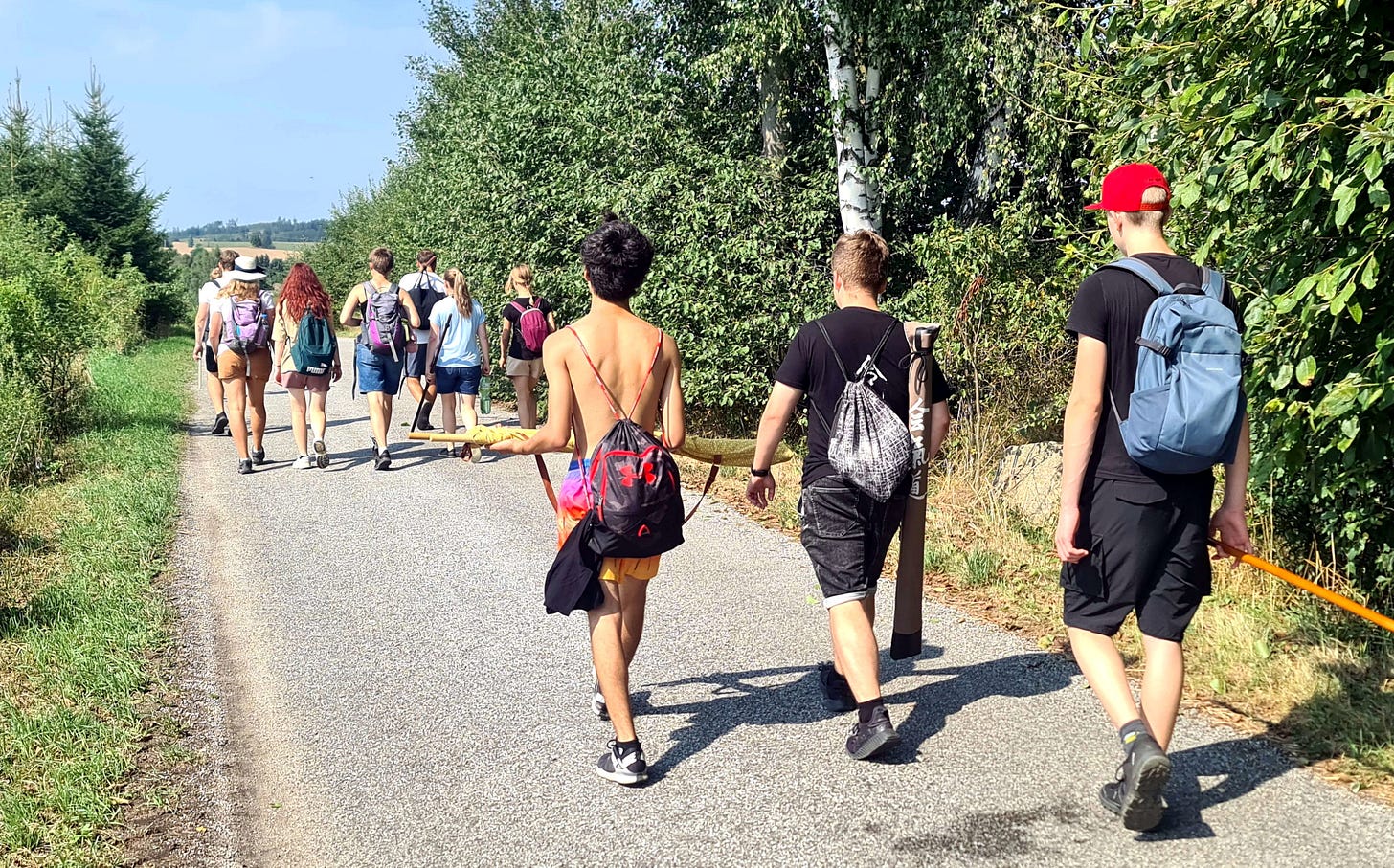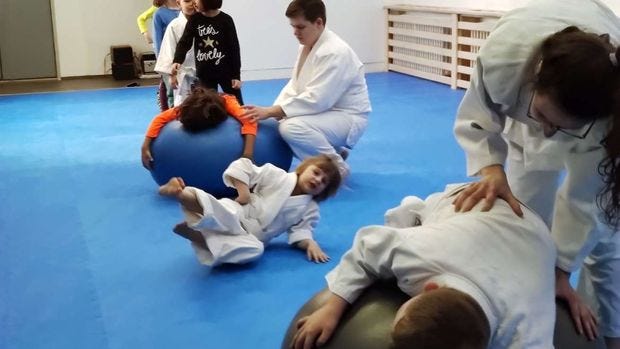4 Key Principles for Teaching Teenagers (Not Just in Aikido)
Why Respect, Peer Groups, Fun, and Responsibility Make All the Difference
Hello everybody. This text is a follow-up article to How to keep youth in Aikido, to which I got quite a lot of feedback. Thank you very much for all your comments on that topic, they helped me to write this text.
Further on, I’ll reveal four underlying principles to run successful Aikido classes for teenagers. But before we get to the main point, I want to address two issues. When reading comments on the previous text, I realized that some important things need more clarity.
Here are two things to understand before working with teenagers:
Teenagers are a special kind!
Some people commenting on my previous article referred to youth classes as children's classes. I got a feeling that they considered children's classes and teenager's classes to be the same. But in fact, teenagers aren’t children. This is very important to understand.
Compared to children or adults, teenagers are a completely different human species. They are a very, very special group with specific needs and they require a completely different approach to teaching. So if you want to have teenagers in your dojo, it’s better if you treat them as a separate group, not as children or adults. In the article below, I will give you some thoughts on how to do it.
Teenagers are great!
Some other people were writing that young people today lack focus and drive, they spend a lot of time on social media… almost suggesting that youngsters nowadays are not good enough to dedicate themselves to demanding work like Aikido.
To be honest, I hear this far too often. If someone (even school teachers) cannot work with teenagers or cannot relate to teenagers, they blame teenagers for that, saying something like “Oh, these youngsters, they are not as we used to be when we were young”.
I have worked with children and youth for 25+ years now and in my experience, young people are as interesting, curious, skillful, focused, and devoted as we were when we were young. Maybe even more. When they are interested in something, they're all in!
Complaining about youth, social media or the world doesn’t help anything. If we want to attract and keep young people in our dojos, we should find ways to make Aikido interesting for them, so that they find its value and progress in it.
I know these are rather optimistic generalizations. It’s just because I prefer to look at opportunities around us, rather than complain about everything.
So these are my two standpoints to start with: 1. teenagers are fantastic and 2. they are a special age group that requires a special approach.
In my experience, there are four things (or practical principles) that fulfill the needs of teenagers:
Respect
Peer group
Fun
Responsibility
This may look scientific and structured but it’s just what we do in our dojo. And because we’re still evolving, please, look at those points as a work in progress.
Ok, let’s go through them briefly:
1. Respect: Treat teenagers as individuals, as equals
My previous article “How to Keep Youth in Aikido” is about this principle - if you want to know more, just read it. Someone wrote a beautiful comment on it, which sums it all up: “Treat them like people. It works.”
Creating an environment where young people feel respected and can develop their individualities is the first thing we should provide. I consider this point to be covered by the mentioned article, so let’s move on to the second most important issue.
2. Peer group: They need to feel they belong
Teenagers need to relate, they need to be part of some group, much more than children and, in a way, much more than adults, too. We should create an environment in the Aikido dojo where teenagers have their peers and can identify themselves as part of this social group. Of course, that is easier said than done.
If there are only old people in a dojo and one teenager comes, he or she will leave because there is no one to whom he/she can relate to. Ideally, we should form a special group for teenagers. As we have children classes, we should have teenagers classes.
And not only that.
There should be more than just Aikido training for this group. In our dojo, we do various social events for teenagers - a sleepover in the dojo, screening of a movie, going to the cinema, having ice cream together, hiking in the mountains… These events are as important as Aikido training because they strengthen social ties; because of these “non-Aikido” events, young people consider Aikido dojo as their environment where they can be themselves and where they can be with their peers. That´s on of the reasons why they stay.
I’ve learned this from Urban Aldenklint, a fantastic teacher from Iyasaka Aikido Dojo in Stockholm - and it was the best advice regarding young aikidokas I’ve ever got.
Considering this point, it also means that the teacher who teaches teenagers should be a person who they can identify themselves with. So the teacher of teenagers should not be distanced, stiff or boring.
Quite the contrary, the teacher of teenagers should be somehow accessible, understand them, and resonate with them. For example, being 46 years old, I consider myself a bit old to teach teenagers. When I do it, I consciously try to be younger. And I'm also delegating these classes to much younger teachers, ideally between 20 and 35 years old.
3. Fun: Yes, it must be fun!
Teenagers need to be interested in what they do and they’re hard to be fooled around. If they don’t like something, that’s it. I personally find it inspiring attitude towards life, don’t you?
Anyway, if teenagers are to stay in an Aikido dojo, we must attract their curiosity, we must make classes that are intriguing for them.
We talked about this with Jacqueline “Aikimama” von Arb just a few weeks ago in Berlin and we got to this simple imperative: “It must be fun!”
It’s a different way of teaching for teenagers, it’s not what we do in children’s classes or classes for adults.
With all respect, Aikido for adults can often be boring - full of talking, reasoning, dull repetition, complicated, uninteresting, or stiff movements, with a lot of musts and don’ts.
Teenagers need to move, to sweat and at the same time the movement should be simple due to their awkward phase of body development. They need new things to feel they are learning. They need something cool, even something a bit risky. Something where the action is mixed with a deep meaning.
Aikido has everything teenagers like and need. But can we show it to them, can we let them experience it?
The training for teenagers should be simple yet attractive, mixing movement exercises, Aikido techniques, weapon practice, and games in a flowing rhythm. It should be animating and exciting.
I agree, it’s extremely difficult to do it. Even though we have thriving teenager groups in our dojo, we’re still improving our ways of teaching them. We know that our classes should be for them in a way as cool as K-pop, street dancing, or skateboarding.
4. Responsibility: Trust them and give them more responsibility
When young people enjoy what they do, after some time we can give them some extra responsibility in Aikido. No hurry, no pressure. Step by step, when they are ready for it.
For example, they can assist in children's classes, take care of younger peers, write an article about a seminar, post on social media, or cook for everybody at a summer school. You might be surprised how responsible and creative they can be. This way they will grow, they will feel even more competent and respected, being a part of the dojo.
First time I found this principle while observing Martin Frankovič from Slovakia to work with teenagers and children in our summer school in the mountains. In a difficult part of our hike, he asked teenagers to help children - which made it safer and easier for everybody. And teenagers were so proud of themselves after they made it!
So we have these four points. We should respect teenagers as we respect adults. We should create an environment where they can build positive relationships with their peers and adult teachers. Their classes must be fun and interesting for them. And they can get more responsibility as they grow.
However, putting these practical principles together is no rocket science, don’t take it too seriously. We can´t force it.
Being a good teacher for teenagers is more of an art, exploration, and mutual communication.
If all this is happening, there’s a pretty good chance that teenagers will have fun and will stay in a dojo. Later, as they become adults, they will develop more mature and serious attitudes towards Aikido.
I believe many of us would be truly happy to have new young adults in our Aikido dojos. Creating a welcoming environment for teenagers is one way to do it. It may take some years and effort but hey, we have time! What do you say?
Please, if you have any thoughts about what I write (agreement or disagreement) or if you find it relevant to your work, leave a comment under the article.
I'm really curious about your feedback and experience - as on tatami, also here any interaction can be very enriching:
A personal note: Our season starts now and I lead a group of teenagers 13 to 15 years old. I must tell you, it's very difficult for me to teach them. I’m quite good with children, I can relate to 16+ young people. But with 13-15, sometimes I can´t find ways to make them interested or to establish communication with them. It’s quite hard to get any feedback from them, too. Sometimes it’s almost scary.
Anyway, teaching this group, I learn a lot, as a teacher and as a human, too.
Wish me luck :)







These are very helpful thoughts. Thank you, Martin!